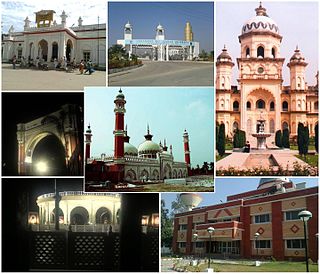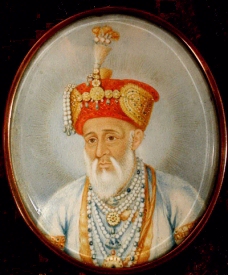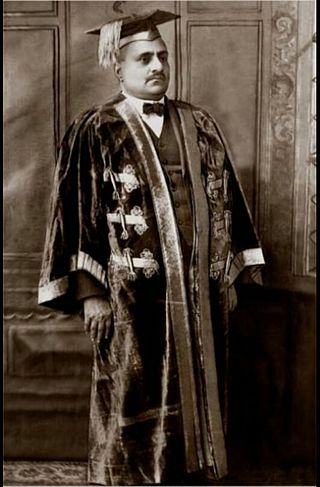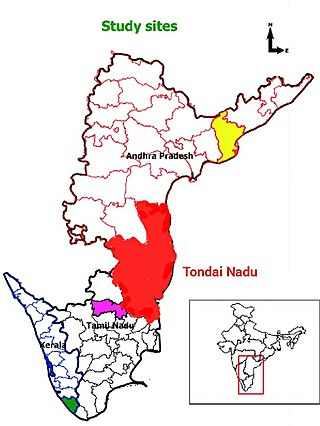| |||||
| Centuries: | |||||
|---|---|---|---|---|---|
| Decades: | |||||
| See also: | List of years in India Timeline of Indian history | ||||
Events in the year 1855 in India .
| |||||
| Centuries: | |||||
|---|---|---|---|---|---|
| Decades: | |||||
| See also: | List of years in India Timeline of Indian history | ||||
Events in the year 1855 in India .

Rampur ( ) is a city, and the municipality headquarter of Rampur District in the Indian state of Uttar Pradesh. It was formerly known for its various industries, like sugar refining and cotton milling. Its library has more than 12,000 rare manuscripts and a fine collection of Mughal miniature paintings. It is located 322 kilometres north-west of the state capital Lucknow.
Ghulam Mohammad, also spelled Ghulam Mohammed, Ghulam Muhammad, Ghulam Muhammed, Gholam Mohammad, Gulam Mohammad etc., is a male Muslim given name. It may refer to:

The Carnatic Sultanate was a kingdom in South India between about 1690 and 1855, and was under the legal purview of the Nizam of Hyderabad, until their demise. They initially had their capital at Arcot in the present-day Indian state of Tamil Nadu. Their rule is an important period in the history of the Carnatic and Coromandel Coast regions, in which the Mughal Empire gave way to the rising influence of the Maratha Empire, and later the emergence of the British Raj.

Muhammad Ali Khan Wallajah, or Muhammed Ali, Wallajah, was the Nawab of the Carnatic from 1749 until his death in 1795. He declared himself Nawab in 1749. This position was disputed between Wallajah and Chanda Sahib. In 1752, after several clashes, Chanda Sahib's forces and his French allies were expelled from Arcot, officially declaring Wallajah as Nawab on 26 August 1765. His reign was recognised by Mughal emperor Shah Alam II.

The Imperial Legislative Council (ILC) was the legislature of British India from 1861 to 1947. It was established under the Charter Act of 1853 by providing for the addition of 6 additional members to the Governor General Council for legislative purposes. Thus, the act separated the legislative and executive functions of the council and it was this body within the Governor General's Council which came to known as the Indian/Central Legislative Council. In 1861 it was renamed as Imperial Legislative Council and the strength was increased.

The Rampur Raza Library located in Rampur, Uttar Pradesh, India is a repository of Indo-Islamic cultural heritage established in the last decades of the 18th century. It was built up by successive Nawabs of Rampur and is now managed by the Government of India, named after Raza Ali Khan Bahadur.

The First Rohilla War of 1773–1774 was a punitive campaign by Shuja-ud-Daula, Nawab of Awadh on the behalf of Mughal Emperor, against the Rohillas, Indian descendants of Afghan highlanders settled in Rohilkhand, northern India. The Nawab was supported by troops of the British East India Company, in a successful campaign brought about by the Rohillas reneging on a debt to the Nawab.

Rampur State was a 15 gun-salute princely state of British India. It came into existence on 7 October 1774 as a result of a treaty with Oudh. Following independence in 1947, Rampur State and other princely states of the area, such as Benares and Tehri Garhwal were merged into the United Provinces. Rampur state had its capital in Rampur city and its total area was 945 sq miles. Rampur state was founded by Ali Mohammad Khan's younger son Faizullah Khan.

Nawab Ahmad Ali Khan Bahadur was Nawab of Rampur from 1794 to 1840, succeeding his brother Ghulam Muhammad Khan Bahadur. The only son of Muhammad Ali Khan Bahadur, Ahmad Ali was made Nawab following the deposition of his uncle Ghulam Muhammad by the British East India Company and the Nawab of Awadh. Ahmad Ali ruled for 46 years, although he reigned from 1794 to 1811 under a regency. He transformed the cultural fabric of Rampur and started a tradition of cultural involvement that has been maintained by his successors to the present day. In 1801, Rampur became a vassal of the HEIC following the cession of Rohilkand by the Nawab of Awadh. Ahmad Ali died on 5 July 1840, aged 52. As his only son had died young, he was succeeded as Nawab by his cousin, Muhammad Said Khan Bahadur.

Nawab Muhammad Said Khan Bahadur was Nawab of Rampur from 1840 to 1855, succeeding his cousin Ahmad Ali Khan Bahadur. The son of Ghulam Muhammad Khan Bahadur, Muhammad Said spent his early years in the service of the East India Company, eventually rising to the rank of Deputy Collector for Dudain. Although his father had been a tyrant during his brief reign, Muhammad Said by contrast proved to be a benevolent and progressive ruler, building irrigation works and establishing courts of law and an advanced legal code. Muhammad Said died on 1 April 1855 in his 69th year and was buried at Rampur. He was succeeded by his eldest son, Yusef Ali Khan Bahadur.

Ghulam Muhammad Ghouse Khan was the 12th and last Nawab of the Carnatic. He reigned from 1825 to 1855. He belonged to the Second Dynasty.

Azim Jah was the brother of Azam Jah, the eleventh Nawab of the Carnatic and uncle of Ghulam Muhammad Ghouse Khan, the twelfth and last Nawab of the Carnatic. He held the title Nawab of Arcot from 1867 to 1874.

The Council of State was the upper house of the legislature for British India created by the Government of India Act 1919 from the old Imperial Legislative Council, implementing the Montagu–Chelmsford Reforms. The Central Legislative Assembly was the lower house.

The Second Rohilla War was a conflict between the Kingdom of Awadh and East India Company, and the Rohillas of Rampur State in 1794.

General elections were held in British India in 1934. The Indian National Congress emerged as the largest party in the Central Legislative Assembly.

General elections were held in British India in 1920 to elect members to the Imperial Legislative Council and the Provincial Councils. They were the first elections in the country's modern history.
General elections were held in British India in November 1923 for both the Central Legislative Assembly and Provincial Assemblies. The Central Legislative Assembly had 145 seats, of which 105 were elected by the public.
Events in the year 1854 in India.
Events in the year 1851 in India.

Tondaimandalam, also known as Tondai Nadu, is a historical region located in the northernmost part of Tamil Nadu and southernmost part of Andhra Pradesh. The region comprises the districts which formed a part of the legendary kingdom of Athondai Chakravarti. The boundaries of Tondaimandalam are ambiguous – between the river basins of Penna River and Ponnaiyar River. During the reign of Rajaraja I, this region was called as Jayankonda Cholamandalam.